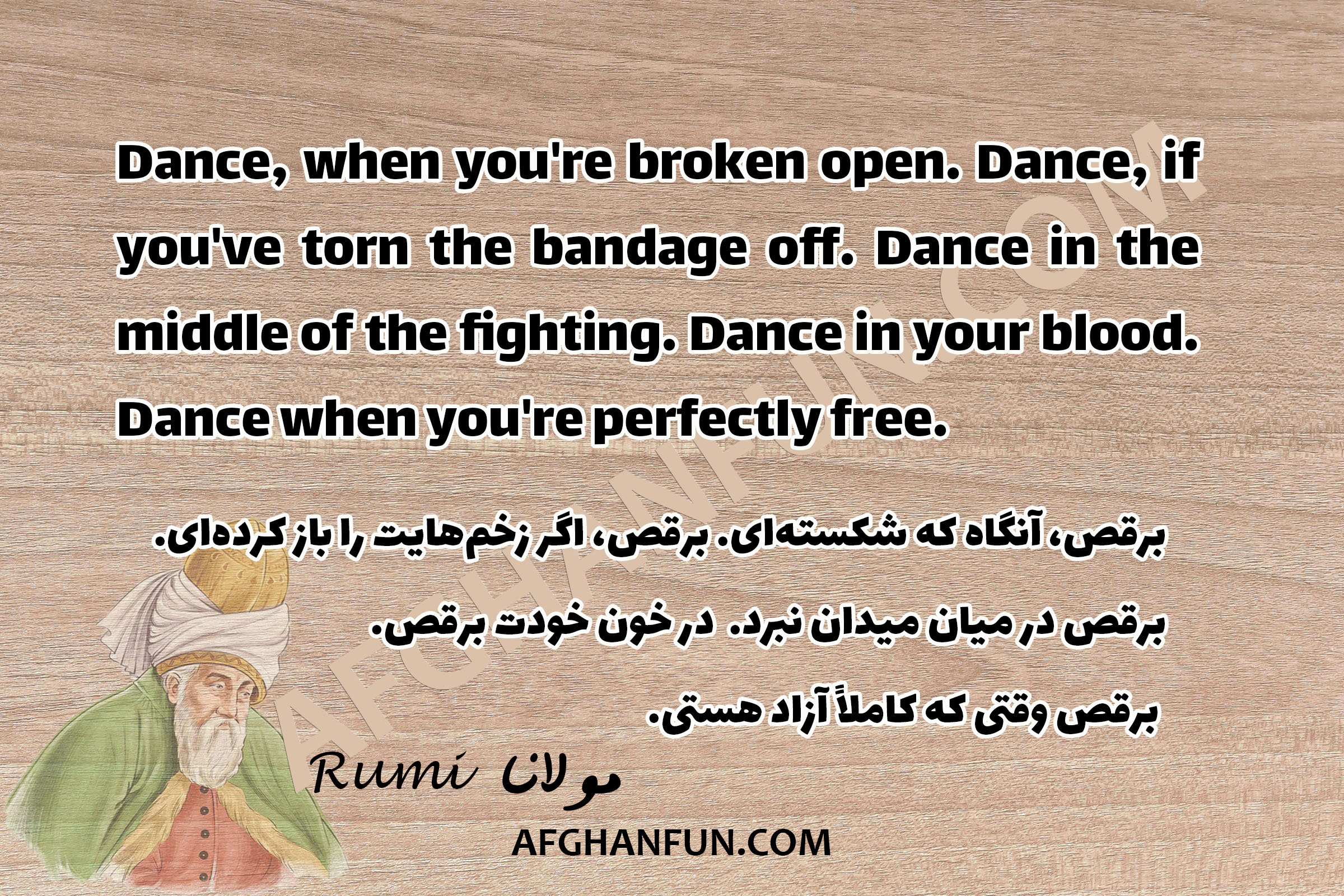Dance, when you’re broken open. Dance, if you’ve torn the bandage off. Dance in the middle of the fighting. Dance in your blood. Dance when you’re perfectly free.
rumi
برقص، آنگاه که شکستهای. برقص، اگر زخمهایت را باز کردهای. برقص در میان میدان نبرد. در خون خودت برقص. برقص وقتی که کاملاً آزاد هستی.
مولانا
این نقل قول مولانا، رقص را بهعنوان نمادی از آزادی و رهایی به تصویر میکشد. او دعوت میکند که حتی در اوج درد، زخم و جنگیدن، همچنان به رقصیدن ادامه دهیم. رقصیدن در اینجا به معنای پذیرش زندگی با تمام رنجها و آزاد شدن از هر محدودیتی است. مولانا از ما میخواهد در لحظهای که کاملاً آزاد و رها هستیم، در خون خود برقصیم؛ گویی رقصیدن به معنای زندگی کردن است، حتی در میان سختیها.
Бирақс, вақте ки шикастаӣ. Бирақс, агар банди захматро кушода бошӣ. Бирақс дар миёни майдони ҷанг. Дар хуни худат бирақс. Бирақс, вақте ки комилан озод ҳастӣ.
МАВЛОНО ҶАЛОЛУДДИН МУҲАММАДИ БАЛХӢ
Ин иқтибос аз Мавлоно рақсидаро чун рамзи озодӣ ва раҳоӣ нишон медиҳад. Вай моро даъват мекунад, ки ҳатто дар авҷи дард, захм ва ҷанг, ҳамоно ба рақс идома диҳем. Рақсидан дар ин ҷо маънои пазируфтани зиндагӣ бо тамоми ранҷҳояш ва раҳо шудан аз ҳама гуна маҳдудиятҳоро дорад. Мавлоно мехоҳад, ки мо дар лаҳзае, ки комилан озод ҳастем, дар хуни худ рақс кунем; гӯё ки рақсидан маънои зиндагӣ кардан аст, ҳатто дар миёни сахтиҳо.
ارقص، عندما تُكسر. ارقص، إذا نزعت الضماد. ارقص في وسط المعركة. ارقص في دمك. ارقص عندما تكون حراً تماماً.
مولانا جلال الدین الرومي
هذا الاقتباس من مولانا يُظهر الرقص كرمز للحرية والانعتاق. إنه يدعونا للاستمرار في الرقص حتى في ذروة الألم والجروح والصراع. الرقص هنا يرمز إلى تقبل الحياة بكل آلامها والتحرر من كل القيود. مولانا يريد منا أن نرقص عندما نكون في أقصى درجات الحرية، وكأن الرقص يعبر عن جوهر الحياة حتى وسط الصعوبات.
In-Depth Analysis
This quote by Rumi is a profound metaphorical call to embrace life’s challenges with a spirit of resilience, acceptance, and inner freedom. The act of “dancing” here is not merely about physical movement but represents a deeper, symbolic expression of how one should respond to the struggles, pain, and chaos inherent in the human experience.
1. Dancing as a Metaphor for Embracing Pain: Rumi’s use of “dance” when “broken open” or after tearing off the “bandage” implies that instead of shying away from pain, we should engage with it fully. The phrase suggests a radical acceptance of suffering — rather than resisting it, one should metaphorically dance with it. This is a transformative act, turning the moments that would typically bring despair into opportunities for spiritual growth. It is an invitation to let pain become a catalyst for self-discovery and renewal.
2. Liberation through Surrender: Rumi emphasizes dancing “in your blood” and “in the middle of the fighting.” These images conjure scenes of intense struggle, yet he urges us to remain engaged in the dance. This can be interpreted as a call to embrace life’s turmoil instead of trying to escape it. By dancing through the chaos, we move beyond mere survival to a place of transcendence. It implies that true freedom comes not from avoiding life’s battles but from meeting them head-on with grace, courage, and a sense of inner liberation.
3. The Concept of Ultimate Freedom: The final exhortation to “dance when you’re perfectly free” suggests that true freedom is not merely the absence of external constraints but an internal state of mind. It’s the ability to remain unshaken by life’s ups and downs. For Rumi, freedom is found in surrender — when we let go of the need to control outcomes, we find ourselves truly liberated. Dancing becomes a metaphor for living in harmony with the flow of existence, free from attachments, fears, and the need for security.
4. Mystical and Spiritual Implications: Rumi, as a Sufi mystic, often spoke of divine love and the soul’s journey toward unity with the Beloved (God). In this context, dancing can also symbolize the ecstatic state of spiritual union. Sufis are known for their practice of the whirling dervishes, where dance becomes a form of meditation and communion with the divine. Thus, the act of dancing here could be seen as surrendering to the divine will, letting go of the ego, and merging with a higher consciousness.
5. Life-Affirming Philosophy: At its core, Rumi’s message is a life-affirming philosophy that encourages us to embrace the fullness of existence, both the joyous and the painful moments. By choosing to dance in the face of adversity, we affirm our commitment to life itself. It’s a reminder that the journey toward wholeness involves not just seeking the light but also dancing through the darkness.
In summary, Rumi’s quote is a poetic and powerful encouragement to face life’s challenges with a fearless heart, to find beauty in the struggle, and to experience true freedom through surrender. It teaches us that by embracing the fullness of our human experience, we can transcend suffering and discover a profound inner liberation.











